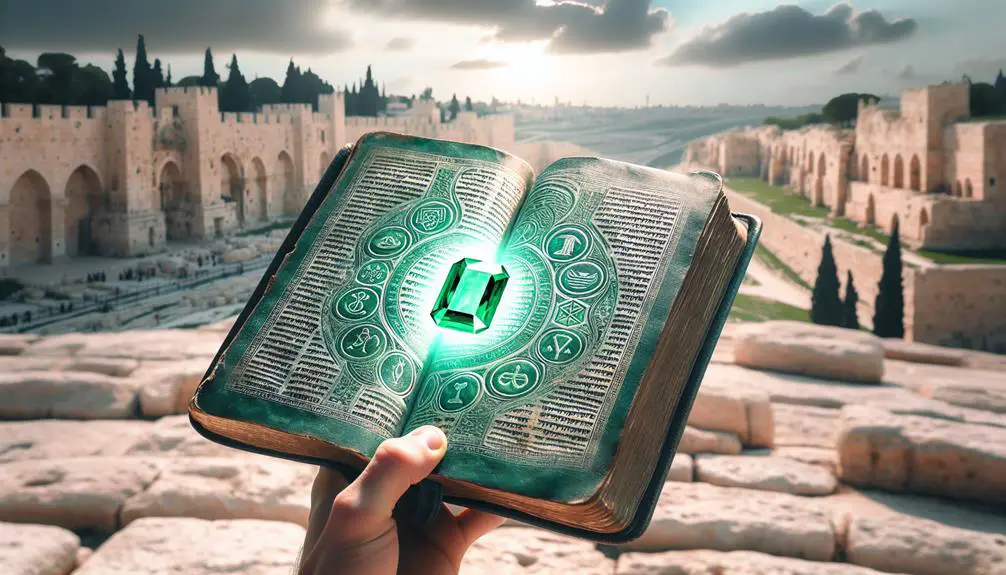Discover the captivating role of emeralds in biblical narratives, symbolizing divine beauty and prophetic visions that spark curiosity and wonder.

Emeralds in the Bible
As they say, all that glitters is not gold, and in the context of the Bible, emeralds hold a fascinating glint of their own. You'll find emeralds, with their rich, green allure, woven into the fabric of biblical narratives, from the High Priest's Breastplate to the prophetic visions in Ezekiel and the foundations of the New Jerusalem.
They're not just stones; they symbolize a deeper spiritual and cultural significance that echoes through centuries. If you've ever wondered how these gems fit into the biblical world and what they meant to those who wrote these ancient texts, there's a rich vein of history and symbolism waiting for you to uncover.
Key Takeaways
- Emeralds symbolize divine communication, eternal splendor, and the bond between earthly and divine realms in biblical narratives.
- They embody themes of rebirth, wisdom, and eternal love, reflecting their cultural and spiritual significance across civilizations.
- The intricate crafting and identification of emeralds for religious artifacts demonstrate ancient expertise in gemology and craftsmanship.
- Their presence in biblical contexts underscores their esteemed status and enduring legacy as symbols of God's eternal nature and divine favor.
The High Priest's Breastplate

Did you know that the High Priest's breastplate, as described in the Bible, wasn't just a ceremonial garment but also a symbol of divine communication, featuring twelve precious stones including emeralds, each representing one of the tribes of Israel? This intriguing artifact, steeped in religious and cultural significance, offers a fascinating glimpse into ancient gem identification and crafting techniques.
The precision involved in selecting and preparing these stones for the breastplate underscores the advanced skills in gem identification possessed by the artisans of that era. Identifying emeralds, known for their vibrant green hue, required a keen eye and extensive knowledge of mineralogy. The fact that emeralds were included among the breastplate's stones highlights their esteemed status and the sophistication involved in distinguishing them from other green gemstones.
Furthermore, the crafting techniques employed to incorporate these gems into the breastplate were equally remarkable. Each stone had to be meticulously cut, polished, and set into the breastplate in a manner that not only ensured their secure attachment but also allowed their individual beauty and significance to shine forth. This process not only demanded a high level of craftsmanship but also an understanding of the symbolic importance of each stone.
In essence, the High Priest's breastplate serves as a testament to the ancient world's mastery of gem identification and crafting techniques. It reflects a deep appreciation for the intrinsic beauty and symbolic power of gems like emeralds, underscoring their role in facilitating divine communication and representing the unity of the tribes of Israel.
Emeralds in Ezekiel's Vision

Continuing our exploration of emeralds in biblical contexts, Ezekiel's vision presents another profound instance where this gemstone's significance is illuminated, reflecting its divine symbolism and cultural importance. In the heart of Ezekiel's imagery, the emerald becomes a beacon of divine glory and mystery, offering layers of vision interpretation that have fascinated scholars and believers alike.
Ezekiel's vision, rich in symbolic language and imagery, holds a special place for the emerald, showcasing its value beyond mere decoration. This context elevates the emerald from its earthly status to a symbol of the divine presence, intertwining material beauty with spiritual significance. The appearance of emeralds within this vision underscores their importance in conveying the ineffable and transcendent aspects of the divine.
To paint a clearer picture for you, consider these points:
- Ezekiel's imagery: The text describes a figure on a throne, surrounded by a radiant spectacle likened to the appearance of a rainbow in the clouds on a rainy day. It's within this celestial panorama that the emerald's presence is felt, symbolizing a divine promise or presence.
- Vision interpretation: Scholars often view the emerald within Ezekiel's vision as a representation of God's glory and eternal nature, offering insight into the gemstone's perceived ability to reflect the divine.
- Cultural importance: The inclusion of emeralds in such a significant prophetic vision underscores the stone's esteemed status in ancient cultures, serving as a bridge between the divine and the earthly.
In analyzing Ezekiel's vision, it's clear that the emerald serves as more than a visual element; it's a symbol laden with theological and cultural weight, offering deep insights into the ancient world's perception of the divine.
Symbolism of Emeralds

Throughout history, emeralds have held a multifaceted symbolism, embodying concepts of rebirth, wisdom, and eternal love in various cultures. These vibrant green stones aren't just captivating to the eye; they're imbued with deep meanings and have been sought after for their perceived powers and beauty. In the context of emerald healing, these gemstones are believed to harbor restorative properties. Cultures across the globe have revered emeralds for their supposed ability to heal both physical ailments and emotional wounds, linking them to the renewal of life force and fostering a sense of harmony and well-being.
Moreover, emeralds have been integral as royal adornments, signifying not just wealth and status but also wisdom and protection. Kings and queens adorned themselves with emeralds, believing these gems would grant them foresight and guard against evil. This association with royalty underscores the emerald's symbolism of power and the divine right to rule, further connecting it to biblical narratives where leaders are often depicted as chosen by God.
Analyzing the symbolism of emeralds within a biblical context enriches our understanding of these texts, revealing layers of meaning that transcend the literal. Emeralds serve as a bridge between the divine and the earthly, symbolizing an eternal bond that reflects God's enduring love and wisdom. In this light, emeralds aren't merely ornamental but are deeply symbolic, representing themes of renewal, healing, and divine favor that resonate through biblical lore.
Emeralds in the New Jerusalem

As we delve into the depiction of the New Jerusalem in the Book of Revelation, it becomes evident that emeralds play a significant role in symbolizing the city's divine perfection and eternal splendor. The vivid imagery presented in the scriptures isn't just a testament to the beauty of these gemstones but also to their profound architectural influence and gem properties that contribute to the overarching symbolism of purity and renewal within the heavenly city.
Emeralds, with their rich green hue, are more than just decorative elements; they embody the essence of life and the rejuvenation of creation. The New Jerusalem, as described, is a place where the flaws and weariness of the old world are replaced with an unblemished and eternal state of being. The inclusion of emeralds in this celestial city's foundation stones speaks volumes about their significance:
- Radiant Color: The deep green color of emeralds symbolizes a flourishing new creation, reminiscent of an everlasting spring.
- Durability and Rarity: These traits of emeralds mirror the eternal and precious nature of the New Jerusalem, suggesting that what's valued is also resilient.
- Healing Properties: Historically, emeralds have been associated with healing and restoration, aligning with the city's role as a place of ultimate restoration for humanity.
Through their gem properties and significant architectural influence, emeralds aren't merely ornamental but serve as a profound symbol of the New Jerusalem's divine qualities. They encapsulate the promise of a new beginning, free from the past's imperfections, and underscore the city's role as a beacon of hope and eternal splendor.
Historical and Cultural Context

Turning our attention to the historical and cultural context, we'll uncover the multifaceted role emeralds have played across civilizations, from ancient symbolism to modern allure. You'll find that emeralds, with their verdant glow, haven't only been cherished for their beauty but have also been at the heart of numerous cultures, symbolizing fertility, rebirth, and wisdom. Delving into the past, it's clear that emerald trade routes were instrumental in the dissemination of these gems, linking distant lands through commerce and cultural exchange.
These ancient networks facilitated not just the spread of emeralds but also the exchange of knowledge, including gemstone authentication methods. In the pursuit of ensuring the genuineness of these prized stones, ancient traders and scholars developed early techniques to distinguish authentic emeralds from mere imitations. This quest for verification speaks volumes about the value placed on emeralds, transcending mere aesthetic appeal to embody a deeper cultural and economic significance.
Moreover, the historical paths carved by the emerald trade have left an indelible mark on societies, influencing art, religion, and even diplomacy. Through these channels, emeralds have woven a rich tapestry of connections, embedding themselves within the very fabric of human history. Thus, when you consider emeralds within the biblical context, it's essential to appreciate not just their symbolic importance but also the complex network of historical and cultural threads that have contributed to their enduring legacy. In this light, emeralds aren't merely gemstones but are emblematic of human civilization's intricate and evolving relationship with the natural world.
Frequently Asked Questions
How Are the Qualities of Emeralds Mentioned in the Bible Relevant to Their Perceived Value and Significance in Modern Gemology?
You're exploring how the attributes of emeralds, as highlighted historically, impact their contemporary value and importance.
The symbolism of emeralds, rooted in deep historical contexts, plays a crucial role in their modern applications and perception.
This connection illustrates that the qualities attributed to emeralds aren't just ancient beliefs but have a tangible influence on their current esteem and utility in gemology, blending historical allure with modern relevance in a unique and enduring way.
Were Emeralds Mentioned in the Bible Sourced Locally or Imported, and What Does That Imply About Ancient Trade Networks?
Ever wondered about the journey of emeralds throughout history?
Considering their origins, these gems were likely imported, shedding light on the intricate trade networks of ancient times.
This importation isn't just a tale of transactions; it narrates the lengths societies went to, valuing beauty and rarity.
The trade implications are vast, revealing a connected world, where the value of emeralds transcended borders, intertwining cultures in a web of commerce and admiration.
How Have Interpretations of the Biblical References to Emeralds Evolved Over Time in Different Christian Denominations?
You'll find that interpretations of emerald symbolism have shifted across Christian denominations over time. These variations highlight denominational differences in theological and cultural contexts.
Initially, emeralds were seen as symbols of God's promise and eternal life. However, as theological perspectives evolved, some denominations began to emphasize their representation of faith and rebirth.
Analyzing these shifts offers insight into broader changes in religious thought and the adaptability of symbolic meanings within Christianity.
In What Other Ancient Texts or Civilizations Outside of the Biblical Context Are Emeralds Similarly Revered, and How Do Those Beliefs Compare?
Emeralds weren't just casually adored; they were practically worshipped in ancient civilizations! Diving into emerald symbolism and ancient myths, you'll discover these gemstones were stars beyond the biblical galaxy.
From the lavish adornments of Egyptian pharaohs to the deep spiritual significance in South American cultures, emeralds symbolized eternal youth, rebirth, and foresight. Analyzing these comparisons, it's clear that reverence for emeralds transcended cultures, embodying universal human desires and aspirations.
Are There Any Notable Artifacts or Historical Pieces of Jewelry Believed to Be Directly Associated With the Biblical References to Emeralds?
When exploring emerald symbolism, it's essential to consider any notable artifacts or historical pieces of jewelry that might be linked to ancient texts.
Unfortunately, there aren't direct associations with biblical references that can be definitively confirmed. However, the reverence for emeralds in various ancient civilizations hints at their significant symbolic value, possibly reflecting or influencing biblical artifacts' depiction.
This comparison allows a deeper understanding of emerald symbolism across cultures.
Conclusion
In investigating the presence of emeralds within biblical texts, it's clear they're not just ornamental but deeply symbolic. The High Priest's breastplate and Ezekiel's vision underscore their significance in divine communication and protection.
Furthermore, their mention in the New Jerusalem's foundations highlights a transcendent beauty. Analyzing these instances within their historical and cultural contexts reveals emeralds as symbols of eternal life and God's glory.
This exploration confirms the theory: emeralds are more than gems; they're theological and eschatological markers within the biblical narrative.



Sign up